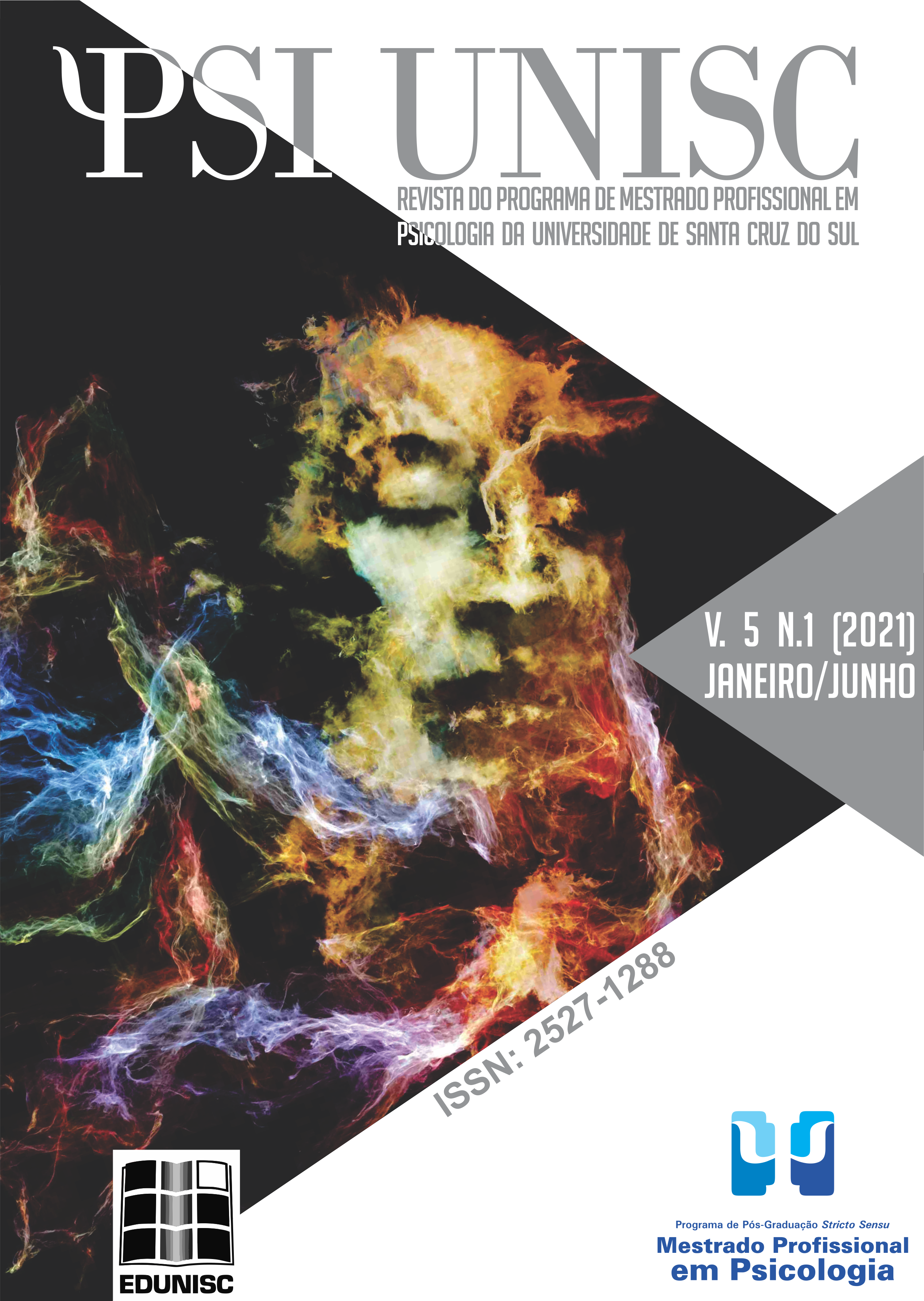Prevention of STI/HIV between lesbian and bisexual women: a bibliographic research (2013-2017)
DOI:
https://doi.org/10.17058/psiunisc.v5i1.14846Keywords:
Prevention, STI, HIV, Lesbian, Bisexual.Abstract
Prevention in STIs/HIV must consider different aspects that can put certain populations in situation of vulnerability. Based on this understanding, this research carried out a bibliographic research about prevention of STIs/HIV among lesbian and bisexual women. The search platforms used were Scielo and the Virtual Health Library (VHL), covering articles in English, Portuguese and Spanish, published between 2013 and 2017. We presented the results and discussion in the form of lines of analysis. These reveal aspects of the vulnerability of the studied public, such as the perception of sexual orientation, race, stigma, unpreparedness of health professionals and lack of knowledge/imprecise knowledge of women related to barrier methods. We point to the need to create policies that address the theme, considering its complexity and the diversity of experiences from the crossing of different social markers. At the end, we indicate suggestions for new studies to be carried out on this theme.Prevention in STIs/HIV must consider different aspects that can put certain populations in situation of vulnerability. Based on this understanding, this research carried out a bibliographic research about prevention of STIs/HIV among lesbian and bisexual women. The search platforms used were Scielo and the Virtual Health Library (VHL), covering articles in English, Portuguese and Spanish, published between 2013 and 2017. We presented the results and discussion in the form of lines of analysis. These reveal aspects of the vulnerability of the studied public, such as the perception of sexual orientation, race, stigma, unpreparedness of health professionals and lack of knowledge/imprecise knowledge of women related to barrier methods. We point to the need to create policies that address the theme, considering its complexity and the diversity of experiences from the crossing of different social markers. At the end, we indicate suggestions for new studies to be carried out on this theme.Downloads
References
Agénor, M., Muzny, C. A., Schick, V., Austin, E. L., & Potter, J. (2017). Sexual orientation and sexual health services utilization among women in the United States. Preventive Medicine, 95, 74-81. doi: 10.1016/j.ypmed.2016.11.023
Ayres, J. R. C. M., Junior, I. F., Calazans, G. J., & Saletti, H. C. F. (2009). O conceito de vulnerabilidade e as práticas de saúde: novas perspectivas e desafios. In: D. Czeresnia, C. M. Freitas, Promoção da saúde: conceitos, reflexões, tendências (pp. 121-144). Rio de Janeiro, FIOCRUZ.
Baquero, R. V. A. (2012). Empoderamento: instrumento de emancipação social? – Uma discussão conceitual. Revista Debates, 6(1), 173-187. doi: 10.22456/1982-5269.26722
Barbosa, B. R. S. N., Nascimento, E. T., Carvalho, I. A. F., & Cavalcante, J. C. D. (2014). Invisibilidade lésbica e a interseccionalidade de opressões. In Anais do 18 Redor, (pp. 3008-3024). Recife, PE: Universidade Federal Rural de Pernambuco. Recuperado de: http://www.ufpb.br/evento/index.php/18redor/18redor/paper/viewFile/2269/821
Batista, M. C. H., & Zambenedetti, G. (2017). Uma pesquisa-intervenção sobre prevenção às IST/HIV com mulheres lésbicas e bissexuais. Psicol. Pesq, 11(2), 42-60. doi: 10.24879/2017001100200180
Bostwick, W. B., Hughes, T. L., & Everett, B. (2015). Health Behavior, Status, and Outcomes Among a Community-Based Sample of Lesbian and Bisexual Women. LGBT Health, 2(2), 121-126. doi: 10.1089%2Flgbt.2014.0074
Carrara, S. (2010). Políticas e direitos sexuais no Brasil contemporâneo. Bagoas, 4(5), 131-147. Recuperado de https://periodicos.ufrn.br/bagoas/article/view/2316
Carvalho, P. M. G., Nóbrega, B. S. M., Rodrigues, J. L., Almeida, R. O., Abdalla, F. T. M. & Nichiata, L. Y. I. (2013). Prevención de enfermidades de transmisión sexual por mujeres homosexuales y bisexuales: estudio descriptivo. Online Brazilian Journal of Nursing, 12(4). Recuperado de: http://www.objnursing.uff.br/index.php/nursing/article/view/4177/html_37
Coulter, R. W. S., Kinsky, S. M., Herrick, A. L., Stall, R. D., & Bauermeister, J. A. (2015). Evidence of Syndemics and Sexuality-Related Discrimination Among Young Sexual-Minority Women. LGBT Health, 2(3), 250-257. doi: 10.1089/lgbt.2014.0063
Daly, F., Spicer, N., & Willan, S. (2016). Sexual rights but not the right to health? Lesbian and bisexual women in South Africa's National Strategic Plans on HIV and STIs. Reproductive Health Matters, 24(47), 185-194. doi: 10.1016/j.rhm.2016.04.005
Doull, M., Wolowic, J., Saewyc, E., Rosario, M., Prescott, T., & Ybarra, M. L. (2017). Why Girls Choose Not to Use Barriers to Prevent Sexually Transmitted Infection During Female-to-Female Sex. Journal of Adolescent Health, 62(4), 411-416. doi: 10.1016/j.jadohealth.2017.10.005
Estrich, C. G., Gratzer, B., & Hotton, A. L. (2014). Differences in sexual health, risk behaviors, and substance use among women by sexual identity: Chicago, 2009-2011. American Sexually Transmitted Diseases Association, 41(3), 194-199. doi: 10.1097/olq.0000000000000091
Facchini, R., & Barbosa, R. M. (2006). Dossiê: Saúde das Mulheres Lésbicas - Promoção da equidade e da integralidade. Belo Horizonte: Rede Feminista de Saúde.
German, D., & Latkin, C. A. (2015). HIV Risk, Health, and Social Characteristics of Sexual Minority Female Injection Drug Users in Baltimore. AIDS Behav, 19(7), 1361–1365. doi: 10.1007/s10461-014-0972-z
Gil, A. C. (2002). Como elaborar projetos de pesquisa (4a ed). São Paulo: Atlas.
Herrick, A., Kuhns, L., Kinsky, S., Johnson, A., & Garofalo, R. (2013). Demographic, Psychosocial, and Contextual Factors Associated With Sexual Risk Behaviors Among Young Sexual Minority Women. Journal of the American Psychiatric Nurses Association, 19(6), 345–355. doi: 10.1177/1078390313511328
Hirata, H. (2014). Gênero, classe e raça: Interseccionalidade e consubstancialidade das relações sociais. Tempo Social, 26(1), 61-73. doi: 10.1590/S0103-20702014000100005
Jesus, J. G. (2012). Orientações sobre a população transgênero: conceitos e termos. Brasília. Recuperado de: https://www.scribd.com/document/87846526/Orientacoes-sobre-Identidadede-Genero-Conceitos-e-Termos
Leite, R. M., & Luna, E. (2002). O Desenvolvimento do campo do conhecimento e da pesquisa em relação à infecção pelo HIV junto aos homossexuais e bissexuais. In Brasil, Novos Desafios da Prevenção da Epidemia pelo HIV/Aids junto aos homens que fazem sexo com homens (pp. 67-68). Brasília, DF: Ministério da Saúde.
Lindley, L. L., Walsemann, K. M., & Carter Jr, J. W. (2013). Invisible and at Risk: STDs Among Young Adult Sexual Minority Women in the United States. Perspectives on Sexual and Reproductive Health, 45(2), 66-73. doi: 10.1363/4506613
Logie, C. H, Alaggia, R., & Rwigema, M. J. (2014a). A social ecological approach to understanding correlates of lifetime sexual assault among sexual minority women in Toronto, Canada: results from a cross-sectional internet-based survey. Health Education Research, 29(4), 671-682. doi: 10.1093/her/cyt119
Logie, C. H., Navia, D., Rwigema, M.-J., Tharao, W., Este, D., & Loutfy, M. R. (2014b). A group-based HIV and sexually transmitted infections prevention intervention for lesbian, bisexual, queer and other women who have sex with women in Calgary and Toronto, Canada: study protocol for a non-randomised cohort pilot study. BMJ Open, 4(4), 1-7. doi: 10.1136/bmjopen-2014-005190
Logie, C. H., Navia, D., & Loutfy, M. R. (2015). Correlates of a lifetime history of sexually transmitted infections among women who have sex with women in Toronto, Canada: results from a cross-sectional internet-based survey. Sex Transm Infect, 91(4), 278-83. doi: 10.1136/sextrans-2014-051745
López, L. C. (2011). Uma Análise das Políticas de Enfrentamento ao HIV/Aids na Perspectiva da Interseccionalidade de Raça e Gênero. Saúde Soc, 20(3), 590-603. doi: 10.1590/S0104-12902011000300006
Ministério da Saúde. Brasil. (2013). Política Nacional de Saúde Integral de Lésbicas, Gays, Bissexuais, Travestis e Transexuais. Brasília - DF: Ministério da Saúde.
Mora, C. M., & Monteiro, S. (2013). Homoerotismo feminino, juventude e vulnerabilidade às DSTs/Aids. Estudos Feministas, 21(3), 905-926. doi: 10.1590/S0104-026X2013000300008
Muranda, T., Mugo, K., & Antonites, C. (2014). HIV is not for me: A study of African women who have sex with women's perceptions of HIV/AIDS and sexual health. African Human Rights Law Journal, 14(2), 757-786. Recuperado de http://www.scielo.org.za/scielo.php?script=sci_arttext&pid=S1996-20962014000200021&lng=en&tlng=en
Muzny, C. A., Austin, E. L., Harbison, H. S., & Hook, E. W. (2014a). Sexual Partnership Characteristics of African American Women Who Have Sex With Women; Impact on Sexually Transmitted Infection Risk. Sexually Transmitted Diseases, 41(10), 611-617. doi: 10.1097/olq.0000000000000194
Muzny, C. A., Harbison, H. S., Pembleton, E. S., & Austin, E. L. (2013). Sexual Behaviors, Perception of Sexually Transmitted Infection Risk, and Practice of Safe Sex Among Southern African American Women Who Have Sex With Women. Sexually Transmitted Diseases, 40(5), 395-400. doi: 10.1097/olq.0b013e31828caf34
Muzny, C. A., Rivers, C. A., Parker, C. J., Mena, L. A. Austin, E. L., & Schwebke, J. R. (2014b). Lack of evidence for sexual transmission of genital Candida species among women who have sex with women: a mixed methods study. Sex Transm Infect, 90, 165-170. doi: 10.1136/sextrans-2013-051361
Palma, D. M., & Orcasita, L. T. (2017). Considerations for the design of Human Immunodeficiency Virus (HIV) prevention programs for lesbian and bisexual women. Interface (Botucatu), 21(63), 1031-1038. doi: 10.1590/1807-57622016.0790
Peres, M. C. C., Soares, S. F., & Dias, M. C. (2017). Dossiê sobre Lesbocídio no Brasil de 2014 até 2017. Rio de Janeiro: Livros Ilimitados.
Piscatelli, A. (2009). Gênero: A história de um conceito. In: H. B. de Almeida, & J. Szwako (Orgs.), Diferenças, igualdade (pp. 116-146). São Paulo: Berlendis.
Poteat, T. C., Logie, C. H., Adams, D., Mothopeng, T., Lebona, J., Letsie, P., & Baral, S. (2015). Stigma, sexual health, and human rights among women who have sex with women in Lesotho. Reproductive Health Matters, 23(46), 107-116. doi: 10.1016/j.rhm.2015.11.020
Rich, A. (2010). Heterossexualidade compulsória e existência lésbica. Bagoas, (5), 17-44. Recuperado de https://periodicos.ufrn.br/bagoas/article/view/2309
Rother, E. T. (2007). Revisão sistemática X revisão narrativa. Acta Paulista de Enfermagem, 20(2), 7-8. doi: 10.1590/S0103-21002007000200001
Schick, V., Pol, B. V. D., Dodge, B., Baldwin, A., & Fortenberry, J. D. (2015). A mixed methods approach to assess the likelihood of testing for STI using self-collected samples among behaviourally bisexual women. Sex Transm Infect, 91, 329–333. doi: 10.1136/sextrans-2014-051842
Silberman, P., Buedo, P. E., & Burgos, L. M. Barreras en la atención de la salud sexual en Argentina: percepción de las mujeres que tienen sexo con mujeres. Rev. salud pública, 18(1), 1-12. Recuperado de https://pesquisa.bvsalud.org/portal/resource/pt/mdl-28453149
UNAIDS - Programa Conjunto das Nações Unidas sobre HIV/AIDS. (2017). Guia de terminologia do UNAIDS. Brasília - DF.
Downloads
Published
How to Cite
Issue
Section
License
The submission of originals to this journal implies the transfer, by the authors, of the printed and digital publication rights. The copyrights for the published articles are those of the author, with periodical rights on the first publication. Authors may only use the same results in other publications clearly indicating this journal as the medium of the original publication. Because we are an open access journal, we allow free use of articles in educational and scientific applications provided the source is cited under the Creative Commons CC-BY license.




